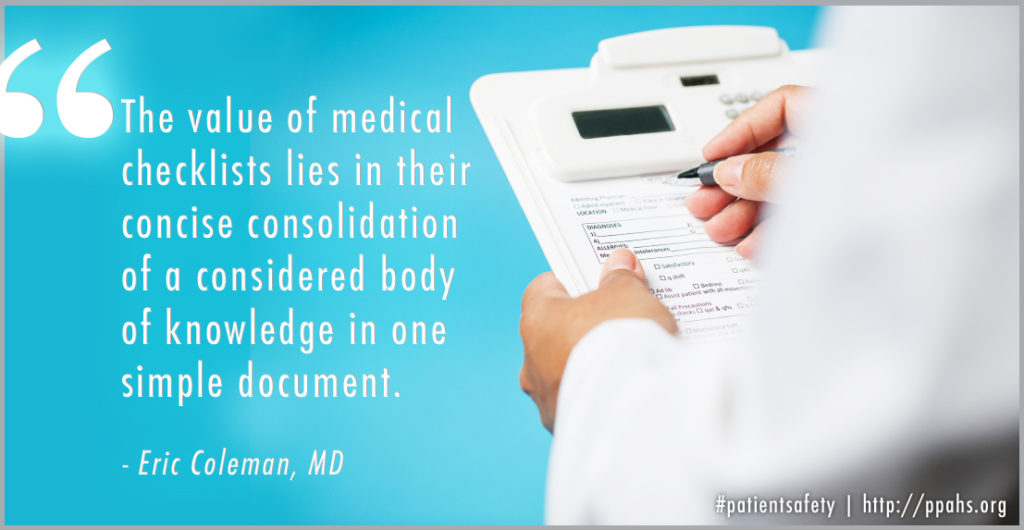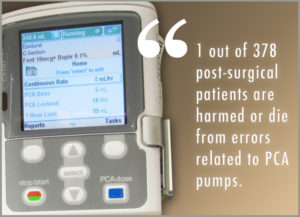
PCA Safety Checklist was developed by an expert panel brought together Physician-Patient Alliance for Health & Safety (PPAHS). PCA stands for patient-controlled analgesia. Patient-controlled analgesia “is a method of pain control that gives patients the power to control their pain. In PCA, a computerized pump called the patient-controlled analgesia pump, which contains a syringe of pain medication as prescribed by a doctor, is connected directly to a patient’s intravenous (IV) line.”
To view and download the PCA Safety Checklist, please click here.

PCA Safety Checklist is a free, downloadable resource for clinicians developed to remind caregivers of the essential steps needed to be taken to initiate PCA with a patient, and to continue to assess that patient’s use of PCA. This checklist was developed after consultation with a group of 19 renowned health experts, including intensive care specialist and a leader in medical checklist development Peter J. Pronovost, MD, PhD, FCCM, Professor, Departments of Anesthesiology/Critical Care Medicine and Surgery, The Johns Hopkins University School of Medicine and Medical Director, Center for Innovation in Quality Patient; and Atul Gawande, MD, Professor in the Department of Health Policy and Management at the Harvard School of Public Health, who is a surgeon at Brigham and Women’s Hospital Professor of Surgery at Harvard Medical School and author of “The Checklist Manifesto.”
PCA Safety Checklist addresses three key patient safety issues:
- A patient can potentially receive too much medication.
- Injury and death can occur even if there are no errors with the pump.
- Oximetry monitoring may not be sufficient.
Expert Opinion On the benefits of the PCA Safety Checklist
Frank Federico, RPh, Patient Safety Advisory Group at The Joint Commission and executive director at the Institute for Healthcare Improvement:
“Use and adherence with standardized processes for eligible patients leads to better clinical outcomes. The PPAHS PCA checklist lays out essential steps to be taken to initiate patient-controlled analgesia (PCA) with a patient and to continue to assess that patient’s use of PCA. Following these steps will help to increase patient safety and save lives.”
Ana Pujols McKee, MD, executive vice president and chief medical officer at The Joint Commission:
“The Joint Commission recognizes there is an opportunity to improve care for patients by improving the safety of opioid use in acute care settings given that data show opioids are among the top three drugs in which medication-related adverse events are reported. Opioids are necessary to prevent suffering, but there are risks related to potency, route of administration, and patient history. By engaging in a comprehensive approach to assessment, monitoring, and patient education, opioid overuse and associated harm can be prevented.”
Dr. Richard Dutton, Executive Director, Anesthesia Quality Institute:
“A checklist would help to avoid simple but recurrent errors in packaging and programming the PCA.”
Dr. Julius Cuong Pham, Department of Emergency Medicine, Department of Anesthesia and Critical Care Medicine, Armstrong Institute for Patient Safety and Quality at Johns Hopkins University School of Medicine:
“In practice, checklists serve as a mental reminder of critical steps that we may or may not remember. Therefore, the value of a checklist with regards to PCAs would be to remind us/double check a critical step in the process.”
Dr. Elliot Krane, Director, Pediatric Pain Management, Lucile Packard Children’s Hospital at Stanford:
“A checklist would help avoid many things that could go wrong with PCA.”
Dr. Andrew Kofke, Co-Director Hospital of the University of Pennsylvania Neurocritical Care Program:
“The use of a well-constructed checklist that ensures proper procedures are followed in patient-controlled analgesia would enhance patient safety.”
Eric Coleman, MD, professor of geriatric medicine and director of the care transitions program at the University of Colorado:
“The value of medical checklists lies in their concise consolidation of a considered body of knowledge in one simple document.”